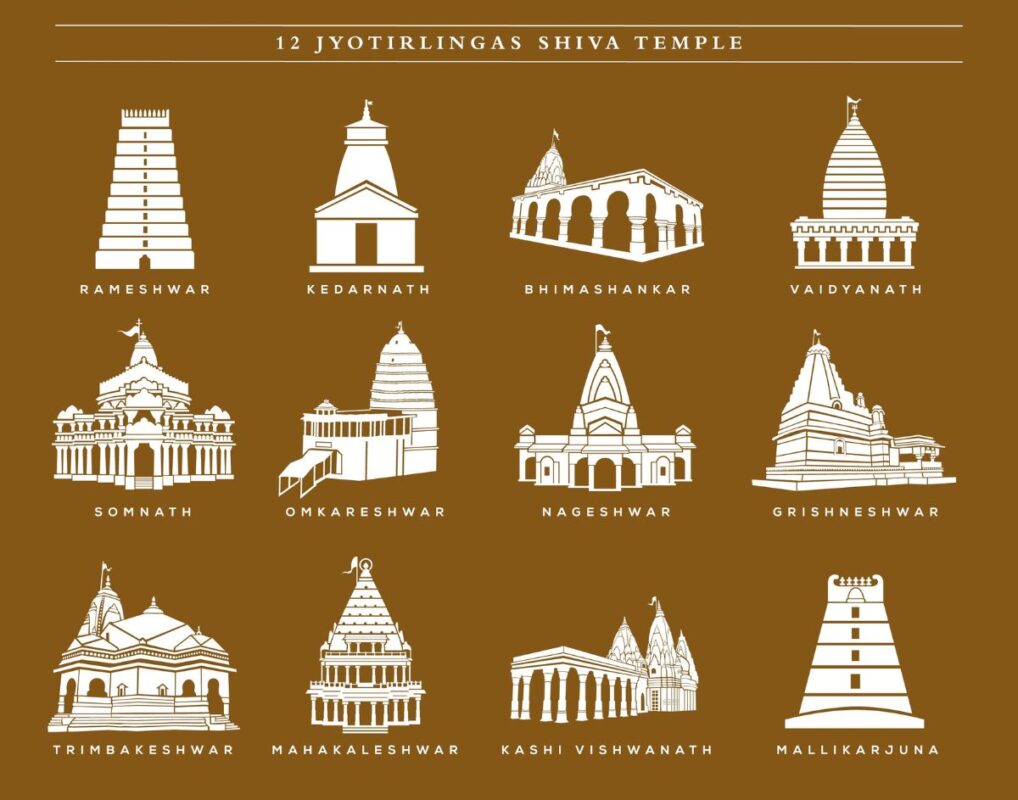The 12 Jyotirlingas are sacred shrines dedicated to Lord Shiva, one of the principal deities in Hinduism. Each of these 12 jyotirlinga temples holds immense religious significance and is a major pilgrimage site for devotees. The word “Jyotirlinga” means “pillar of light,” symbolizing the infinite nature of Shiva. Here are the details about each of these 12 jyotirlinga along with their associated mantras:
Table of Contents
Somnath Jyotirlinga (Gujarat):
Location: Prabhas Patan, near Veraval in Saurashtra, Gujarat.
Significance: It is believed to be the first among the 12 Jyotirlingas. The temple has a rich history and has been reconstructed multiple times due to various invasions.
Legend: According to legend, the Moon God, Chandra, was cursed by his father-in-law, Daksha, to lose his luster. He prayed to Lord Shiva at this site, who then restored his brilliance.

Mallikarjuna Jyotirlinga (Andhra Pradesh):
Location: Srisailam, on the banks of the Krishna River.
Significance: This temple is considered one of the Shakti Peethas in the 12 jyotirlinga, where the goddess Parvati is worshipped as Mallika.
Legend: It is said that Lord Shiva and Parvati appeared here to bless their son Kartikeya, who was upset after losing a race to his brother Ganesha.
Mahakaleshwar Jyotirlinga (Madhya Pradesh):
Location: Ujjain, on the banks of the Kshipra River.
Significance: The only among 12 Jyotirlinga which faces south direction. This symbolizes Lord Shiva as the ruler of death.
Legend: A demon named Dushana terrorized the city of Avanti. Lord Shiva appeared and vanquished the demon, manifesting as the Jyotirlinga here.
Omkareshwar Jyotirlinga (Madhya Pradesh):
Location: Mandhata Island in the Narmada River.
Significance: The island is shaped like the sacred Om symbol. Omkareshwar means “Lord of Omkara” (another name for Shiva).
Legend: According to legend, Vindya, the deity controlling the Vindhyachal mountains, prayed to Shiva to be more powerful than Mount Meru. Shiva granted his wish and manifested as Omkareshwar and Amaleshwar.
Kedarnath Jyotirlinga (Uttarakhand):
Location: In the Himalayas, near the Mandakini River.
Significance: It is one of the most remote among 12 Jyotirlinga and part of the Chota Char Dham pilgrimage.
Legend: After the Mahabharata war, the Pandavas sought Lord Shiva’s blessings to atone for their sins. Shiva disguised himself as a bull and hid in Kedarnath, where he ultimately revealed himself and forgave them.

Bhimashankar Jyotirlinga (Maharashtra):
Location: Pune district, surrounded by dense forests.
Significance: The river Bhima is said to have originated from Lord Shiva’s sweat after his battle with the demon Tripurasura.
Legend: Lord Shiva took the form of Bhimashankar to defeat Tripurasura, who was causing havoc in the region. The victory led to the emergence of the Bhima River.
Kashi Vishwanath Jyotirlinga (Uttar Pradesh):
Location: Varanasi, on the banks of the Ganges River.
Significance: Varanasi is considered one of the holiest cities, and the temple symbolizes Shiva as the ruler of the universe.
Legend: It is said that whoever dies in Varanasi attains salvation and freedom from the cycle of rebirths, as Lord Shiva whispers the Taraka mantra in their ear.

Trimbakeshwar Jyotirlinga (Maharashtra):
Location: Near Nashik, at the source of the Godavari River.
Significance: The unique lingam has three faces representing Brahma, Vishnu, and Shiva.
Legend: Gautama Rishi, a sage, prayed to Shiva for the Ganges to cleanse him of a sin he didn’t commit. Shiva manifested here and allowed the Godavari to flow from the site.
Vaidyanath Jyotirlinga (Jharkhand):
Location: Deoghar.
Significance: Known as Baidyanath Dham, it is believed Shiva cures all ailments here.
Legend: Ravana, the demon king, meditated and offered his ten heads to Shiva. Pleased with his devotion, Shiva manifested and healed Ravana’s injuries, thus being called Vaidyanath (the doctor).
Nageshwar Jyotirlinga (Gujarat):
Location: Near Dwarka.
Significance: Represents protection from poisons and negative energies.
Legend: A demon named Daruka imprisoned a Shiva devotee named Supriya. Shiva appeared and defeated Daruka, saving Supriya and establishing the Jyotirlinga.
Ramanathaswamy Jyotirlinga (Tamil Nadu):
Location: Rameswaram Island.
Significance: Associated with Lord Rama’s quest to rescue Sita from Ravana.
Legend: Rama worshipped Shiva here to absolve his sins after the battle with Ravana. He installed a Shiva lingam, which is worshipped as Ramanathaswamy.

Grishneshwar Jyotirlinga (Maharashtra):
Location: Near Ellora Caves.
Significance: The smallest among 12 Jyotirlinga temple, reflecting rich cultural heritage.
Legend: A devout woman named Kusuma was a great devotee of Shiva. Her devotion and penance led to Shiva manifesting as Grishneshwar to fulfill her wishes.
The Jyotirlinga Mantra
Here’s the powerful mantra that encompasses all 12 Jyotirlingas:
Saurashtre Somanathamcha Srisaile Mallikarjunam|
Ujjayinya Mahakalam Omkaramamaleswaram ||
Paralyam Vaidyanathancha Dakinyam Bheema Shankaram |
Setu Bandhethu Ramesam, Nagesam Darukavane||
Varanasyantu Vishwesam Tryambakam Gautameethate|
Himalayetu Kedaaram, Ghrishnesamcha shivaalaye||
Etani jyotirlingani, Saayam Praatah Patennarah|
Sapta Janma Kritam pApam, Smaranena Vinashyati||
Each of these 12 Jyotirlingas holds a unique legend and significance, reflecting the rich tapestry of Hindu mythology and devotion. Chanting these mantras is believed to invoke blessings from Lord Shiva and bring spiritual enlightenment to devotees. Visiting these sacred shrines is considered a way to cleanse one’s soul and experience divine grace.







